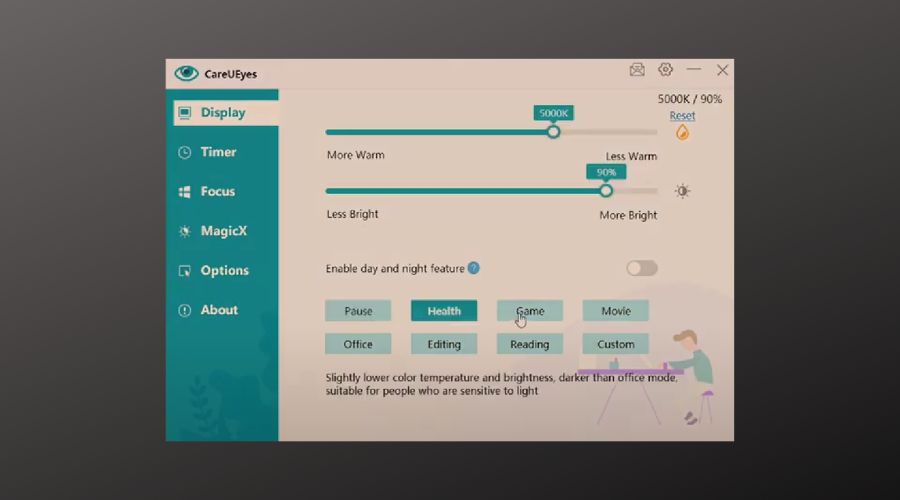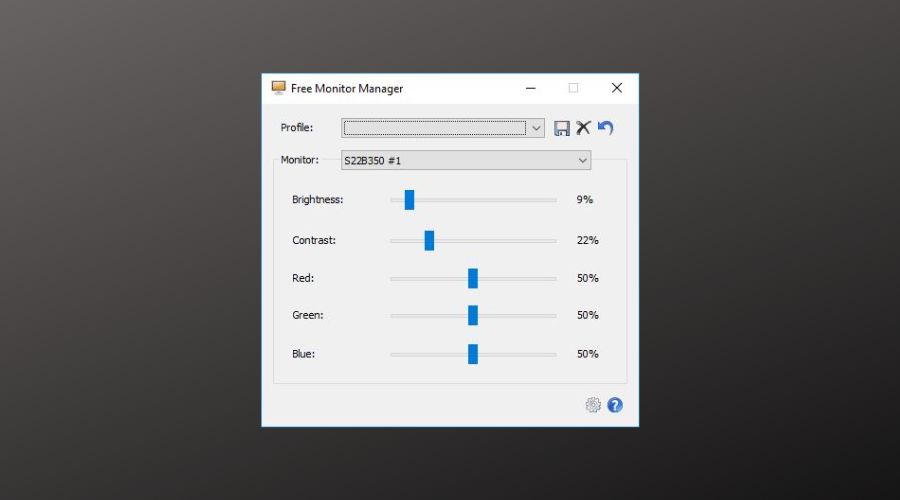10 Best Monitor Brightness Control Software

Adjusting your monitor’s brightness and contrast is crucial for reducing eye strain and enhancing comfort. Whether you’re working for long hours or gaming, using the right software can make a noticeable difference. Here are the best tools for adjusting your monitor’s brightness and contrast.
Best Monitor Brightness and Contrast Adjustment Tools
1. LightBulb

LightBulb is an open-source application that adjusts your screen’s gamma settings based on the time of day. It’s reducing blue light in the evening to help you sleep better.
Once installed, LightBulb quietly resides in your system tray. You can set your location for accurate sunrise and sunset times and tweak your color temperature preferences.
It automatically adjusts the color temperature throughout the day while still offering a manual override.
Pros:
- Automatically reduces eye strain by adjusting color temperature.
- Free and open source.
Cons:
- May not suit tasks that demand precise color accuracy.
Experience adaptive screen lighting with LightBulb.
2. CareUEyes

CareUEyes is designed to protect your eyes by filtering blue light, adjusting screen brightness, and prompting you to take regular breaks.
Featuring a user-friendly interface with preset modes for activities like reading or gaming, CareUEyes is simple to install and runs unobtrusively in the background.
You can manually adjust both the color temperature and brightness, while break reminders help promote healthier screen habits.
Pros:
- Comprehensive eye protection features.
- Built-in break reminders.
Cons:
- Some advanced options require a paid upgrade.
- May not offer as much customization as some other tools.
Protect your eyes with CareUEyes.
3. ScreenBright

ScreenBright is a lightweight utility that lets you adjust your monitor’s brightness, contrast, and color luminance.
ScreenBright features a simple slider-based interface and is portable—you can run it directly from a USB drive without installation.
It provides basic control over brightness, contrast, and color settings. However, it requires a DDC/CI or USB-control–compatible monitor to operate.
Pros:
- Lightweight and portable.
- Easy-to-use interface.
Cons:
- Limited functionality compared to more advanced tools.
- Dependent on compatible hardware.
Adjust your display settings with ScreenBright.
4. ClickMonitorDDC

ClickMonitorDDC offers powerful control over your monitor’s brightness, contrast, and volume—all from your system tray.
After downloading, ClickMonitorDDC runs in the system tray, providing quick access to settings via sliders or mouse wheel adjustments.
This tool gives you extensive control over multiple monitors and supports command-line arguments for automation. It requires DDC/CI support to function properly.
Pros:
- Comprehensive control over monitor settings.
- Lightweight and unobtrusive.
Cons:
- Compatibility depends on your monitor’s DDC/CI support.
- The interface might seem less intuitive for newcomers.
Manage your monitor settings with ClickMonitorDDC.
5. Win10 Brightness Slider

Win10 Brightness Slider is a straightforward utility that adds a brightness slider to your taskbar for quick adjustments.
This portable tool automatically places a brightness slider in your system tray once run, enabling swift adjustments.
It provides basic brightness control across multiple monitors but requires DDC/CI–compatible hardware.
Pros:
- Simple, easy-to-use interface.
- Portable and lightweight.
Cons:
- Limited to brightness adjustments only.
- Requires compatible monitor hardware.
Simplify brightness control with Win10 Brightness Slider.
6. f.lux

f.lux is one of the most popular tools for reducing blue light exposure by dynamically adjusting your screen’s color temperature based on the time of day.
f.lux runs in the background and automatically shifts your screen’s color temperature according to your location and the time, making setup quick and hassle-free.
While it automatically manages most adjustments, you can still manually tweak warmth and brightness settings if desired.
Pros:
- Intuitive, automatic adjustments.
- Helps improve sleep by reducing blue light.
Cons:
- Limited advanced brightness control.
- May not be ideal for color-sensitive work.
Adjust your display for better sleep with f.lux.
7. Gammy

Gammy is an open-source tool that smartly adjusts your screen’s brightness based on what’s displayed, reducing eye strain during long sessions.
Operating in the background, Gammy automatically detects content on your screen and adjusts brightness accordingly.
Focused primarily on dynamic brightness adjustments, it offers less detailed control over color settings.
Pros:
- Dynamically reduces eye strain by adapting brightness.
- Free and open source.
Cons:
- Limited to brightness control.
- Fewer customization options compared to other tools.
Reduce eye strain with Gammy.
8. Eye Saver

Eye Saver is an easy-to-use program that protects your eyes by filtering blue light and reminding you to take breaks.
Its straightforward interface allows you to set up blue light filters and break reminders easily.
You can adjust the intensity of the blue light filter and configure break notifications to help reduce eye fatigue.
Pros:
- Promotes eye health by reducing blue light exposure.
- Helpful break reminders.
Cons:
- Fewer advanced features and customization options.
- Some features may require a paid upgrade.
Protect your vision with Eye Saver.
9. Free Monitor Manager

Free Monitor Manager lets you adjust your monitor’s brightness and contrast using simple hotkeys or through its interface.
Interface and Setup:
The tool sports a simple interface for quickly adjusting brightness and contrast settings.
Depth of Control:
It offers basic control for your monitor’s settings but is limited to certain monitor models.
Pros:
- Easy-to-use and straightforward.
- Quick adjustments via hotkeys.
Cons:
- Limited compatibility with monitor types.
- Lacks advanced control features.
Control your monitor settings with Free Monitor Manager.
10. Iris Mini

Iris Mini is a streamlined version of the Iris suite that focuses on protecting your eyes by reducing blue light and adjusting brightness.
Featuring a minimalistic interface, Iris Mini keeps things simple with basic settings for color temperature and brightness adjustments.
It concentrates on essential adjustments for eye protection without the extra bells and whistles of more advanced versions.
Pros:
- Simple and user-friendly design.
- Lightweight and effective at reducing eye strain.
Cons:
- Lacks advanced features.
- Focuses solely on blue light reduction and brightness.
Safeguard your eyes with Iris Mini.
Additional Articles You Might Find Helpful:
- Monitor Test Software: 5 Best Tools to Use
Reviews tools for testing and calibrating your monitor to ensure optimal display quality. - How to Increase Brightness of Laptop [Acer, Dell, HP]
Guides for adjusting the brightness on different laptop models. - How To Rotate Your Monitor Screen Display
Learn how to rotate your monitor’s display for presentations or other tasks.
Conclusion
Choosing the right monitor brightness control software depends on your specific needs and hardware compatibility. These tools offer a range of features from basic brightness adjustments to comprehensive eye protection functionalities. Always ensure that your monitor supports the necessary protocols, such as DDC/CI, to utilize these applications effectively.





User forum
56 messages